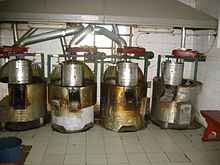パンプキンシードオイル



パンプキンシードオイル(英語: pumpkin seed oil)は、主に中央ヨーロッパで用いられる調理用の油である。
調理用の利用
[編集]この油は、かつてオーストリア=ハンガリー帝国の一部で、現在のオーストリア南東部(シュタイアーマルク州)、スロベニア東部(シュタイエルスカ地方及びプレクムリェ地方)、トランシルヴァニア中央部、ルーマニアのオラシュティエ=クジア地域、クロアチア北西部(特にメジムリェ郡)、ヴォイヴォディナ、及びハンガリーの隣接地域の名物であった。また、北アメリカ、メキシコ、インドや中国を含む世界中で使われている[1]。
パンプキンシードオイルは、強いナッツの風味を持ち、多価不飽和脂肪酸の含量が多い。茶色の油は苦い味であり、リンゴ酢等と混ぜてサラダ用のドレッシング等に用いる。また、デザートに用いることもあり、バニラアイスクリームにかけるとナッツの味が加わる。オーストリアやスロベニアの名物とされ、パンプキンスープやその他の現地の料理に数滴かけて用いられる。しかし、加熱して用いると、必須脂肪酸が壊れてしまう[2]。
製法
[編集]この油は、溶媒抽出法か、超臨界二酸化炭素法により抽出される[3]。油の抽出の後に、カロテノイド等をさらに個別に抽出することもできる[3]。
オーストリアやスロベニアの輸出品であるスティリアンオイルは、現地種のカボチャ"Styrian oil pumpkin" (Cucurbita pepo subsp. pepo var. styriaca)[4][5]のパンプキンシードの殻を取り、ローストしたものを圧搾して作られる。高温でローストすることにより、香りをさらによくすることができる[6]。
種子の種類と油
[編集]

この油は粘度が高く、サンプルの厚さ(光学的距離)に応じて色は黄緑色から深緑色、深赤色である。薄い層では緑色に見え、厚い層では赤色に見え、この光学現象はダイクロマティズムと呼ばれる[7]。パンプキンシードオイルは、最も強いダイクロマティズムを持つ物質の1つである。クレフトの二色性指数は-44である[8]。
別の種類のパンプキンシードオイルも世界中で流通している。殻付きの白い種子を用いたもので、安価な白色の油となる。
12の異なるカボチャの栽培種に由来するパンプキンシードオイルについて、いくつかの脂肪酸の含量は、以下の範囲であった[9]。
| n:unsat | 脂肪酸 | % |
|---|---|---|
| (14:0) | ミリスチン酸 | 0.09–0.27 |
| (16:0) | パルミチン酸 | 12.6–18.4 |
| (16:1) | パルミトレイン酸 | 0.12–0.52 |
| (18:0) | ステアリン酸 | 5.1–8.5 |
| (18:1) | オレイン酸 | 17.0–39.5 |
| (18:2) | リノール酸 | 36.2–62.8 |
| (18:3) | α-リノレン酸 | 0.34–0.82 |
| (20:0) | アラキドン酸 | 0.26–1.12 |
| (20:1) | ガドレイン酸 | 0–0.17 |
| (22:0) | ベヘン酸 | 0.12–0.58 |
ミリスチン酸とパルミチン酸の含量の合計は12.8-18.7%であり、不飽和脂肪酸の合計含量は、73.1-80.5%である。18炭素原子以上の超長鎖脂肪酸の含量は、0.44-1.37%であった。
出典
[編集]- ^ Ahmed Shaban; Ravi P Sahu (2017). “Pumpkin Seed Oil: An Alternative Medicine”. Int J Pharmacogn Phytochem Res 9 (2): Abstract. doi:10.25258/phyto.v9i2.8066. OCLC 7015943627. PMC 8681145. PMID 34924730.
- ^ “Healthy Cooking Oils”. University of Kansas Medical Center. 2013年9月4日時点のオリジナルよりアーカイブ。2013年9月17日閲覧。
- ^ a b Durante, M.; Lenucci, M. S.; Mita, G. (2014). “Supercritical Carbon Dioxide Extraction of Carotenoids from Pumpkin (Cucurbita spp.): A Review”. International Journal of Molecular Sciences 15 (4): 6725–6740. doi:10.3390/ijms15046725. PMC 4013658. PMID 24756094.
- ^ Fürnkranz, Michael; Lukesch, Birgit; Müller, Henry; Huss, Herbert; Grube, Martin; Berg, Gabriele (2012). “Microbial Diversity Inside Pumpkins: Microhabitat-Specific Communities Display a High Antagonistic Potential Against Phytopathogens”. Microbial Ecology 63 (2): 418–428. doi:10.1007/s00248-011-9942-4. JSTOR 41412429. PMID 21947430.
- ^ Košťálová, Zuzana; Hromádková, Zdenka; Ebringerová, Anna (August 2009). “Chemical Evaluation of Seeded Fruit Biomass of Oil Pumpkin (Cucurbita pepo L. var. Styriaca)”. Chemical Papers 63 (4): 406–413. doi:10.2478/s11696-009-0035-5.
- ^ Procida, G.; Stancher, B.; Cateni, F.; Zacchigna, M. (2013). “Chemical composition and functional characterisation of commercial pumpkin seed oil”. Journal of the Science of Food and Agriculture 93 (5): 1035–41. doi:10.1002/jsfa.5843. PMID 22936573.
- ^ Kreft, Samo; Kreft, Marko (November 2007). “Physicochemical and Physiological Basis of Dichromatic Colour”. Naturwissenschaften (Springer Science+Business Media) 94 (11): 935–939. Bibcode: 2007NW.....94..935K. doi:10.1007/s00114-007-0272-9. PMID 17534588.
- ^ Kreft, Samo; Kreft, Marko (2009). “Quantification of Dichromatism: A Characteristic of Color in Transparent Materials”. Journal of the Optical Society of America (Optical Society of America) 26 (7): 1576–1581. Bibcode: 2009JOSAA..26.1576K. doi:10.1364/JOSAA.26.001576. PMID 19568292.
- ^ Stevenson, D. G.; Eller, F. J.; Wang, L.; Jane, J.; Wang, T.; Inglett, G. E. (2007). “Oil and Tocopherol Content and Composition of Pumpkin Seed Oil in 12 Cultivars”. Journal of Agricultural and Food Chemistry 55 (10): 4005–4013. doi:10.1021/jf0706979. PMID 17439238. Note: The data are found in Table 3 on page 4010
- ^ Kreft, M., Zorec, R., Janeš, D., Kreft, S. (2009). Histolocalisation of the oil and pigments in the pumpkin seed. Annals of Applied Biology, 154:413–418
外部リンク
[編集] ウィキメディア・コモンズには、パンプキンシードオイルに関するカテゴリがあります。
ウィキメディア・コモンズには、パンプキンシードオイルに関するカテゴリがあります。
| 調味料 |
| |
|---|---|---|
| 種類 |
| |
| ブランド名 |
| |
|
| ||
Text is available under the CC BY-SA 4.0 license; additional terms may apply.
Images, videos and audio are available under their respective licenses.

